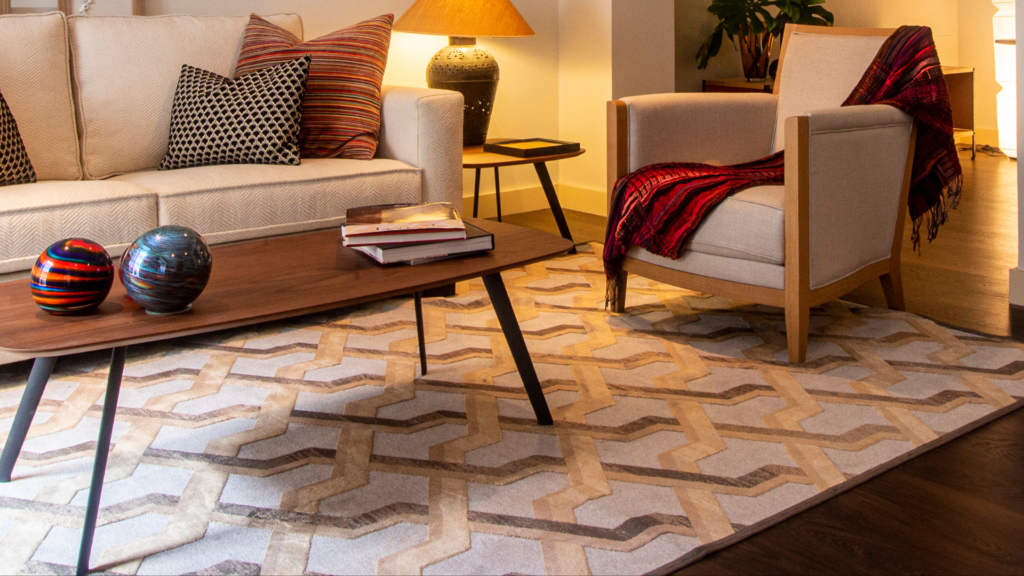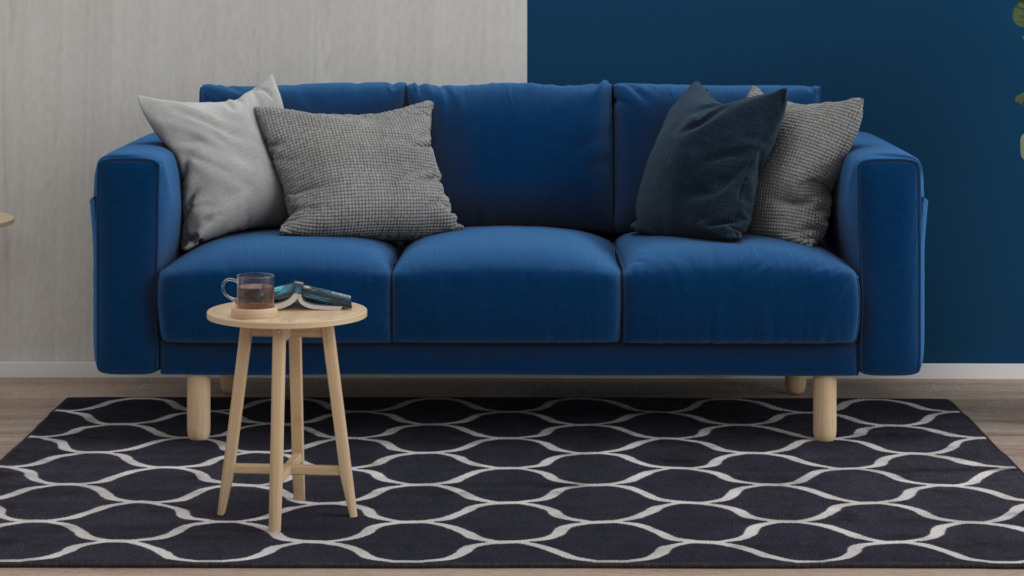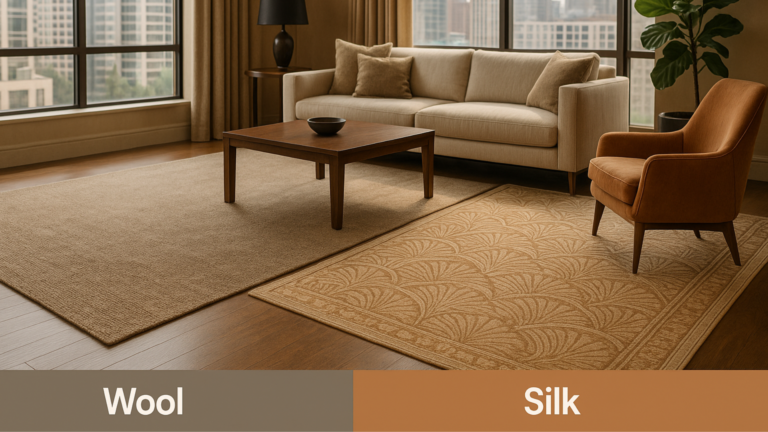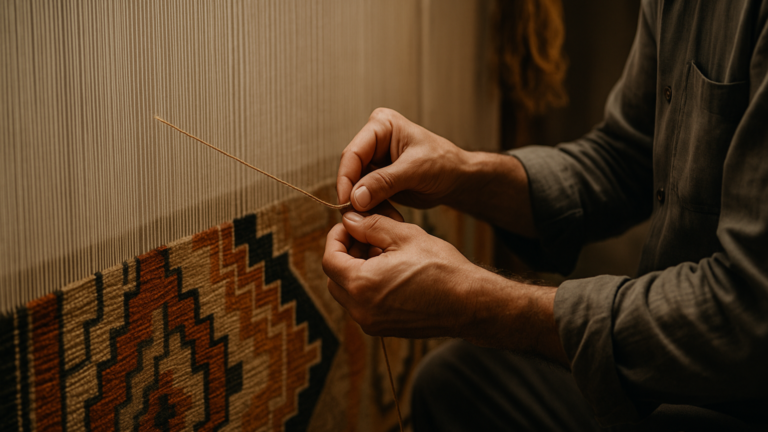
Designing a Custom Rug That Matches Your Decor
Custom Rug That Matches Your Decor: A rug is more than just a floor covering. It can add warmth, reduce noise, define zones in an open-plan home, and provide a touch of style that ties your entire interior together. When you pick a custom-made rug, you have the opportunity to match it precisely with your existing decor. You can select the colors, patterns, and designs that reflect your unique taste while enhancing the overall look of your home.
However, choosing a custom rug that coordinates well with your interiors can be a challenging task. Factors such as color palette, furniture style, wall finishes, and the general mood of the room all play a role. Without the right plan, you might end up with a rug that looks out of place or fails to blend in. In this blog, we will walk through practical tips for selecting a custom rug that complements your decor. We will discuss color selection, pattern choices, style coordination, and other crucial points so that your rug truly becomes a valued part of your space.
Whether your style leans toward classic Indian motifs, modern minimalism, or a mix of influences, the suggestions outlined here will help you focus on what really matters. By the end, you should have a strong grasp of how to plan your custom rug, ensuring it harmonizes with your existing design elements. Also, you will see how a reputable brand like Carpetsandrug can support you in making the best choices.
Table of Contents
1. Start with Your Interior’s Color Palette

Color is a key element in any home decor plan. It sets the tone and mood of a space, influencing how you feel when you enter the room. When designing a custom rug, begin by examining the primary color palette in the area where the rug will lie.
- Look at the Dominant Colors: Identify what shades are already dominant in your room. This can include the sofa fabric, wall paint, curtains, or large decorative pieces. You do not necessarily need a rug that has the exact same hue, but it should link to at least one or two main colors to maintain a sense of unity.
- Check Secondary Hues: Beyond your main color, there might be accent shades used in cushions, artwork, or small accessories. Including these secondary colors in your rug’s design can bring subtle harmony.
- Assess Warm vs. Cool Shades: Rooms that have mostly warm tones, such as reds, oranges, or golden browns, might pair well with a rug that has warm undertones. Similarly, if your space features cool tones like blues, greens, and grays, a rug that includes cooler shades might fit better.
- Use a Neutral Base: If your room already has strong color statements, consider choosing a rug with neutral tones (like beige, cream, or soft gray) and small accent colors. This approach helps avoid overwhelming the space with too many bright hues.
- Think About Light: Rooms that receive ample natural light can handle bolder or darker rug colors, while low-light areas might benefit from lighter or more reflective tones to make the space appear bigger and brighter.
By thoughtfully connecting the rug’s colors with those of your decor, you set a solid base for creating visual coherence. This prevents the rug from clashing with your existing furniture and walls.
2. Consider the Patterns in Your Space

Patterns can be a bold or subtle way to bring life into your decor. A rug’s pattern can do many things: highlight a focal point, balance solid furniture pieces, or add depth to a plain background. However, patterns can also conflict with one another if you are not careful.
- Look at Existing Patterns: Do you have patterned wallpaper, striped curtains, or floral upholstery? A heavily patterned rug might compete with these existing elements, creating a chaotic effect. On the other hand, if your furniture and walls are mostly solid colors, a patterned rug can become a standout feature.
- Choose a Main Focus: In any given room, it is wise to limit how many large-scale patterns you use. If you want the rug’s pattern to be the star, ensure the rest of your decor is more subdued. Alternatively, if your sofa or drapes already have a striking print, opt for a rug with a simpler motif.
- Scale the Patterns Carefully: The size of the pattern should match the scale of the room and its furnishings. Small, repeated patterns might look too busy in an expansive living room, while very large motifs could overwhelm a small bedroom.
- Cultural and Personal Preferences: In Indian homes, you might lean towards local prints, geometric shapes, or stylized florals reminiscent of traditional block printing. If you love such designs, integrate them into your rug in a harmonious way.
- Mix and Match with Caution: It is possible to mix different patterns if you balance them thoughtfully. For example, pair large, bold motifs on the rug with subtler, smaller prints on cushions or curtains.
If you keep these considerations in mind, you will be more likely to pick a pattern that complements your interior rather than clashing with it. Choosing a custom pattern through Carpetsandrug offers you the freedom to fine-tune the design until it feels just right.
3. Style Coordination: Contemporary, Traditional, or Fusion?
When designing a custom rug, it is helpful to identify your room’s overall style. This guides you in selecting a design that supports the same look and feel. Each style category has its own characteristics:
- Traditional Indian Decor: This style often features rich colors like deep reds, golds, and browns, along with ornate wooden furniture and textured fabrics. A traditional rug might have classic motifs—such as Paisley, Mughal-inspired florals, or intricate borders—that complement carved furniture pieces or antique showpieces.
- Contemporary Minimalism: Modern homes often feature neutral color schemes, open layouts, and sleek furniture with straight lines. A rug with a simple geometric pattern or subtle textures can align with this approach. Neutrals like gray, beige, or off-white often work well here. You might add small pops of color to connect with other accent pieces.
- Eclectic or Fusion: Many Indian households blend Western and local influences, using a mix of modern furniture, traditional artwork, and vibrant accents. In such spaces, a custom rug can serve as the middle ground. It could have a traditional pattern done in contemporary shades, or a modern shape featuring ethnic motifs.
- Rustic and Bohemian: If you love handcrafted items, earthy tones, and a casual vibe, you might choose a rug with organic textures (like jute or wool) and patterns that reflect nature or tribal art. In bohemian settings, layered rugs or mixing patterns can be a creative twist.
- Industrial or Urban Chic: Spaces with exposed brick, metal accents, and a neutral palette can benefit from rugs that add warmth. Solid colors or lightly distressed patterns might break the monotony of metal and stone surfaces.
Once you know your dominant style or combination of styles, it becomes simpler to brainstorm rug designs that fit. This alignment ensures the rug feels naturally integrated into your space.
4. Think About Rug Size and Shape
Selecting colors and patterns is important, but the rug’s dimensions and form also impact how it blends with your decor. Even the perfect design can look misplaced if the rug size or shape is off.
- Fit Your Furniture Layout: In living rooms, rugs often anchor the seating area. Ensure your rug is large enough so that at least the front legs of sofas and chairs are on it, creating a unified conversation area. In dining rooms, the rug should extend beyond the table’s edges so chairs stay on the rug, even when they are pulled out.
- Choose the Right Shape: Rectangular rugs suit many standard living areas or bedrooms, but round rugs can highlight a small seating nook or a circular dining table. Runners are useful for hallways or placing alongside a bed.
- Consider Proportions: A small rug floating in a big room can seem out of place, while an overly large rug might make the room appear cramped. Measuring your floor space carefully helps you avoid these mistakes.
- Balance with Walls and Lighting: If you have colorful walls or strong patterns on them, a large rug with too many competing elements may lead to a cluttered look. A slightly smaller rug or a more minimalistic design might allow your walls to stand out.
- Collaboration with Experts: When ordering from Carpetsandrug, do not hesitate to share your room dimensions, photos, or even a floor plan. This helps them propose sizes and shapes that blend well with your furniture arrangement.
Rug size and shape affect not only visual appeal but also how people move through the room. Make sure to plan a layout that keeps walkways free and does not block doors or cabinets.
5. Coordinate Textures and Materials
Sometimes, even if you choose matching colors and patterns, a rug can appear mismatched if its texture or material is not in line with the rest of the space. For instance, a shiny silk rug might feel out of place in a laid-back living room with cotton and cane furniture.
- Blend with Existing Textiles: Look at your sofa upholstery, curtains, or table linens. If they have a plush feel, a dense wool rug can complement them. If the furniture has a breezy cotton or linen vibe, a lighter weave or a flat-woven rug might be more appropriate.
- Consider Room Function: A bedroom often calls for a softer, cozier feel. Wool or shag rugs can bring warmth underfoot. In a high-traffic area, you might opt for more durable fibers like synthetics or wool blends that can handle everyday wear.
- Climate Realities: Some materials, like wool or thick-pile rugs, add warmth but could be stuffy in a humid climate. Alternatively, cooler materials like jute or cotton might be better in regions with high temperatures.
- Layering Possibilities: In some home styles, layering a smaller, decorative rug over a larger, neutral rug creates an interesting look. This approach can merge different textures—like placing a low-pile rug over a thicker one—providing extra visual contrast.
- Budget Concerns: Materials vary in cost, so understanding your budget helps narrow down your options. Silk or high-quality wool can be more expensive, while wool blends or well-made synthetics can provide a balance of durability and affordability.
A carefully selected texture ensures your rug not only looks good but also fits in with the tactile feel of your entire room.
6. Watch the Lighting and Room Ambiance
Lighting has a big influence on how colors and patterns appear. A rug you saw in a showroom might look different under your home’s lighting conditions, particularly if you have a specific type of bulb or limited natural light.
- Check Colors in Daylight: If you are picking out swatches or samples, try to see them in natural sunlight. Colors often look brighter in daylight and more muted under artificial light.
- Indoor Lighting Types: Warm-toned bulbs can make oranges, reds, and yellows look more vibrant but may dull cool blues and grays. Cool-toned bulbs might emphasize cooler colors and dim warmer tones.
- Avoid Overly Dark Choices in Gloomy Rooms: If a room does not get much sun, a dark-colored rug could make it feel smaller. A lighter rug can brighten the space and give an impression of openness.
- Large Windows: Spaces with ample windows can showcase more saturated rug colors. However, too much direct sunlight can eventually fade some dyes. Consider using blinds or curtains to protect delicate materials.
By understanding how different lighting conditions affect your rug, you can ensure your final choice looks the way you imagined once placed in your home.
7. Balancing Trends and Timeless Elements
While it is tempting to go for the latest design trends, remember that a custom rug is a substantial investment meant to serve you for a long time. Opting for a pattern or color that quickly goes out of style can lead to regret.
- Incorporate Popular Hues Moderately: If you love a trendy color, incorporate it in smaller portions. For example, choose a neutral base with highlights of the trend color, making it easier to adapt if styles shift.
- Focus on Classic Patterns: Geometric designs, subtle stripes, or understated floral motifs have a long history of popularity. These are less likely to seem outdated in a few years.
- Complement Instead of Replicate: Try not to replicate every trending fad in your rug. Instead, let the design complement bigger statements you have in furniture or artwork.
- Reflect Your Personality: Ultimately, your custom rug should speak to your tastes. If you feel a strong emotional connection to certain colors or patterns, do not be afraid to include them. Trends come and go, but personal comfort and joy in your home are vital.
Selecting a design that balances current preferences with more classic touches can give your rug broader appeal, ensuring you continue to appreciate it year after year.
8. Make the Rug a Cohesive Part of the Room
After deciding on colors, patterns, and sizes, think about how the rug will engage with other major elements in your space. Is there a coffee table that will rest on the rug? Are there side tables or shelves that might block part of the design? Remember that your rug should not live in isolation.
- Align Focal Points: If there is a fireplace, a TV console, or a large window that serves as the room’s focal point, arrange the rug so it aligns with or supports that feature. This can help draw the eye in a pleasing way.
- Coordinate with Accessories: Small items like throw pillows, curtains, or lampshades can link the rug’s colors or patterns to the rest of the decor. This creates harmony even if the rug design is more elaborate.
- Use an Anchor Piece: In some rooms, the rug sets the foundation for everything else. If you start with the rug design, pick accent colors for accessories or seat cushions based on the rug’s palette to ensure consistency.
- Avoid Clutter: A visually complex rug paired with too many decorative items can look crowded. Strike a balance between your rug’s visual weight and the rest of your furnishings.
When your rug design ties together with these details, your space feels more intentional and comfortable.
9. Consult with Experts for a Tailored Outcome
Designing a custom rug might seem straightforward at first, but there are subtle details that can make a big difference. Collaborating with professionals—like the team at Carpetsandrug—can simplify the process:
- Material Selection: Experts can advise on wool, silk, synthetic blends, or natural fibers like jute, depending on your lifestyle and climate conditions.
- Color Matching: They can help you pick the right hue from hundreds of options, ensuring the final rug matches the swatch or sample you envision.
- Precise Customization: From weaving techniques to finishing touches, an experienced brand can cater to your requests, delivering a rug that truly reflects your preferences.
- Time and Budget: Professionals can provide an estimate on how long weaving might take, along with cost breakdowns for more intricate designs or premium materials.
Having specialized support not only saves time but also increases the likelihood of ending up with a rug that meets your expectations.
10. Practical Maintenance Considerations
While style and design are important, you should also think about how you will maintain the rug over its lifespan. A rug that complements your decor beautifully is still a hassle if it requires overly complicated upkeep.
- Vacuuming: Regular vacuuming, about once or twice a week, prevents dirt buildup. This is especially true if you select a thicker pile rug.
- Spot Cleaning: If your rug has lighter tones, be prepared for more visible stains. Keep mild cleaners or homemade solutions ready for quick spill cleanups.
- Material Resistance: Wool is naturally stain-resistant, silk is more delicate, and synthetic fibers can be easier to clean. Factor in how often the rug might experience foot traffic or spills.
- Professional Cleaning: Periodically, you might send your rug for a professional wash, especially if it is made from wool or silk, to renew its vibrancy and remove embedded dirt.
- Rotation: In a room with uneven sunlight or traffic flow, rotating the rug every six months can even out fading and wear.
By setting up a simple cleaning schedule, you will help maintain the rug’s fresh look and ensure its design stays consistent with the rest of your decor.
11. The Role of Personal Taste
While you should certainly consider current styles and tips from design experts, do not overlook your own preferences. A custom rug is a personal piece, often created to last for years. If you love certain shades or patterns—even if they are less conventional—incorporating them can make the rug more meaningful.
- Personal Stories: Sometimes, a color or motif can remind you of a cherished memory or place. Including that in your rug design gives your home a personal touch.
- Confidence in Decisions: If professionals suggest a particular trend but it does not resonate with you, speak up. It is your home, and you have to feel comfortable with the end result.
- Long-Term Satisfaction: A rug is not a trivial purchase. Unlike small decorative items, it requires planning and investment. Ensuring it aligns with your taste will reduce the chance of regret later on.
Striking a balance between expert recommendations and your personal tastes usually leads to the best outcome, especially if you aim for a cohesive interior style that stands the test of time and shifting trends.
12. How Carpetsandrug Helps You Get the Best Results
Carpetsandrug has a proven track record in guiding homeowners through the complexities of designing a custom rug. Here is how they can support you:
- Consultation: Before production starts, they discuss your needs, from color preferences to budget constraints. If you share pictures of your room or color swatches, they can provide expert suggestions.
- Sample Approvals: Where possible, you can view small samples to see how the shades and textures look under your home’s lighting before finalizing.
- Quality Materials: Using high-grade wool, silk, synthetic blends, or other natural fibers ensures the rug meets top standards.
- Skilled Craftsmanship: Their weavers pay close attention to detail, ensuring the design you envision is accurately translated into the final piece.
- Post-Sales Guidance: After you receive your custom rug, they can offer advice on placement, cleaning, and long-term care.
Working with a reputable provider simplifies the entire journey. This collaborative process helps you feel confident that your finished rug will match your decor in color, pattern, and overall style.
Conclusion
Designing a custom rug that blends seamlessly with your decor can elevate the look and feel of your living space. However, the process involves more than picking out a random color or pattern. You have to consider the existing color palette, your chosen interior style, rug size, shape, texture, and your personal preferences. Together, these factors create a cohesive design that showcases your taste while adding warmth and purpose to your room.
By methodically planning the rug’s colors, patterns, and materials, you can avoid common issues like clashing tones or an out-of-scale design. Pay attention to lighting conditions, and try to balance your preference for trends with more established design elements that will hold up over time. If you are unsure about any aspect, partnering with an experienced brand like Carpetsandrug can provide valuable assistance. They will help you navigate the complexities, from design brainstorming and material selection to final installation.
Ultimately, a carefully chosen custom rug can become a signature piece in your home—one that not only completes your interior design but also stands as an expression of your personal taste. By following these steps and trusting professional advice when needed, you will be on your way to having a rug that truly feels like it was made just for you.
Frequently Asked Questions
- Is there a general rule for matching a custom rug’s colors to my sofa or curtains?
Select at least one color that appears in your sofa or curtains for subtle coordination. You can balance it with neutral hues if you do not want an exact color match. - Which rug materials work best in hot and humid areas of India?
Lighter or breathable materials like cotton or jute can help in humid climates. Wool is also an option if you keep the area well-ventilated to manage moisture. - How do I prevent my custom rug from looking too large in a small room?
Measure carefully and ensure some space remains between the rug’s edges and the walls. A rug that is too close to each wall can make the room feel crowded. - Should the rug design or wall color be chosen first when redecorating?
It varies. Some people pick the rug design first as it can be harder to match afterward, while others already have wall colors and need the rug to fit in. Both sequences can work if planned properly. - What if I need to adjust the final design of my custom rug after seeing a sample?
Contact the rug provider, like Carpetsandrug, as soon as possible. Minor changes might be possible, especially if weaving has not advanced too far.



